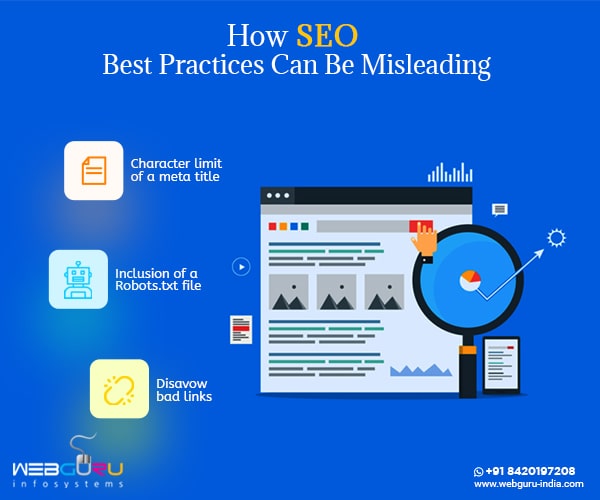Home Blog SEO Services How SEO Best Practices Can Be Misleading
How SEO Best Practices Can Be Misleading
- 12 Aug / 2019
- 5,088 views

In the digital ecosystem, letting your website gain high visibility on Search Engine Result Pages would mean following the best SEO practices. However, such practices can lead to missed opportunities as well as many among them are mere myths rather than having any substance. So, let us understand what these best practices are and how often are they followed like a routine by the global or local SEO services.
What are the SEO best practices?
These are methodologies that have been generally accepted by professional SEO services and digital marketers as the best ways to optimize websites for search engines. These constitute title lengths, word counts of content, meta description etc. So, why do we follow such practices? Do they really help to achieve results like better visibility, leads, and conversions? Let us find out.
What are the benefits of SEO best practices?
For any industry or business, SEO can have many imponderables. Since algorithms running search engines to rank websites are not exactly known to all and sundry, SEO best practices are the legit and secured ones to follow. These show a clear path and give a sense of comfort to the stakeholders (read digital marketers and clients) having less or no experience. Moreover, clients can derive a sense of contentment in knowing that their SEO experts are following the best practices. This can reassure them of the success of their SEO campaign. Also, more often than not, SEO best practices can lead websites to better their search rankings. Therefore, in a digital landscape where myths abound and ‘expert advice’ is often delivered on a platter, pursuing SEO best practices can be a good policy.
However, there can be times when ‘best practices’ may not be the best and turn out to be mere ‘myths’ or part of the SEO folklore. There are many grey areas where considerable differences abound among SEO practitioners. These differences continue to linger in the absence of any confirmation from the search engines. Most differences revolve around factors that Google uses to rank websites on its search pages. For example, even seasoned SEO professionals are unsure of the Click-Thru-Rate (CTR) being a ranking factor. Let us understand that search engine algorithms are complicated and not known outside the organizations developing them.
So, should ‘experts’ start dishing out the advice of particular practices being the best to deliver results without being confirmed by the search engine, it needs to be considered with a pinch of salt. Moreover, there are ‘influencers’ dime a dozen who are known to give insights into SEO practices thereby leading to confusion. A newbie SEO professional can get conflicting signals thinking what to believe and what to reject. And matters can become even more complicated when influencers may not agree on a given point. So, what to do, whom to believe and which practices to follow? For starters, let us look at a few examples where some of the SEO best practices have become myths only leading to missed opportunities.
# Character limit of a meta title: There is a general agreement of sorts among SEO professionals that a meta title should have a maximum length of 60 characters. This is born out of the fact that meta titles get truncated across displays of various devices. However, Google does not suggest any maximum limit and merely states the titles not to be unusually long or verbose as they are likely to be truncated in the search results. Currently, Google truncates titles that exceed 600 pixels. So, thinner characters (I) will take fewer pixels vis-à-vis- the thicker ones (W). Moreover, Google does not leave the truncated portions from crawling. Thus, sticking to an arbitrary character limit of sixty can lead the search engines to miss valuable keywords, which you could have included for optimization.
# Inclusion of a Robots.txt file: It is worth mentioning that a robots.txt file does not affect the crawling or indexing of a site. So, it seems to be followed blindly as a rule without accruing any significant benefits for the specific website. Such inclusion can increase the cost and turnaround time of any SEO process carried out by a top SEO agency in India or elsewhere.
# Disavow bad links: The disavow tool on Google search console is often used arbitrarily to remove ‘bad’ links, which otherwise had been nurtured over a period of time. However, Google does not advocate such a thing as evident in the recent pronouncement by Google’s John Mueller. According to him, random links collected over a period of time are not necessarily harmful. He stressed the need to remove links that are paid for or have been placed unnaturally.
Conclusion
SEO best practices give practitioners and clients a sense of security and confidence. However, not all practices need to be followed as routine but evaluated based on experience and for specific projects only. Therefore, should you be looking at enhancing the prospects of your business by following the best SEO practices, contact an experienced SEO company today!
1 comment
Leave a Reply

-
1000+
Happy
Clients -
25+
Countries
Served -
19+
Years of
Trust









thanks for this great information content about SEO.